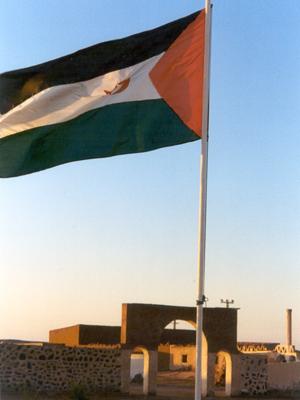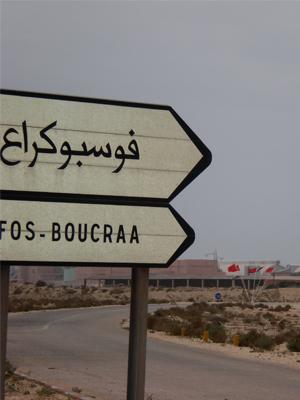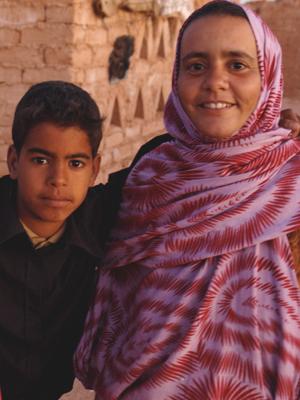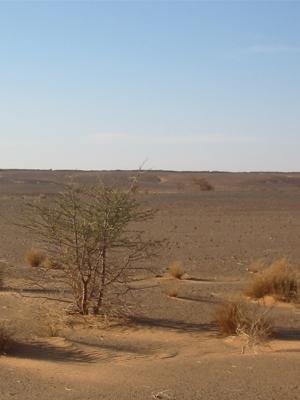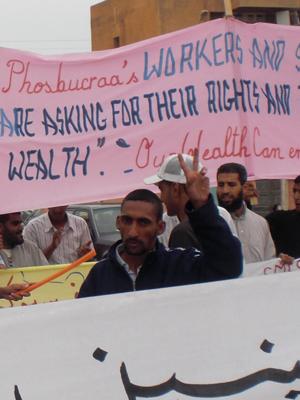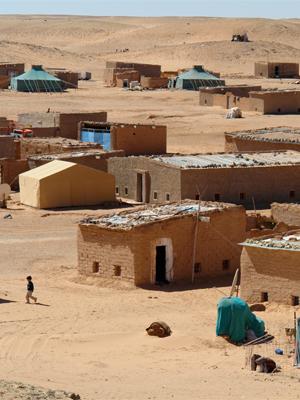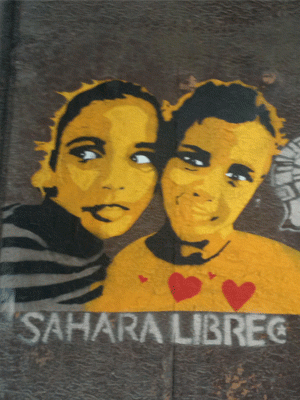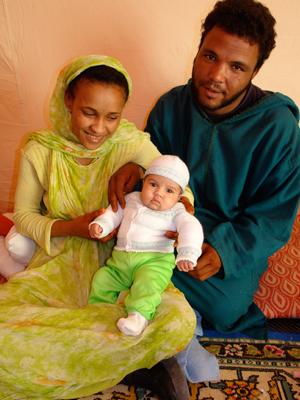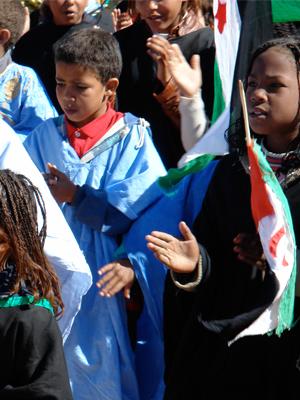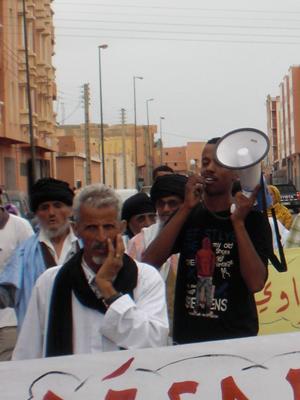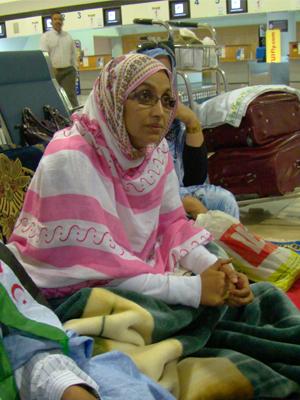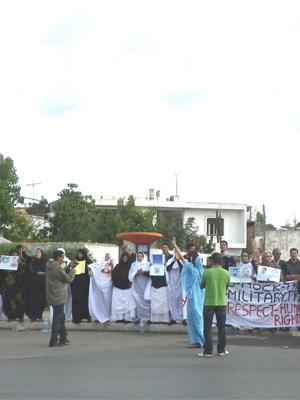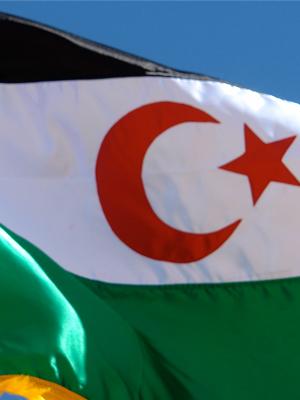western sahara
a two thousand four hundred kilometre, heavily mined wall, the moroccan wall, cuts a line through western sahara. what purpose does it serve and what are the conditions like around it?
The military wall or berm is known by Saharawis as the Wall of Shame. It was built in various stages in the 1980s with money from the USA and Saudi Arabia to stop incursions by the Polisario guerillas over the lines held by Moroccan forces. At certain points in the 16 year-long war, the Saharawis held the bulk of the territory. Their fortunes waxed and waned. Now they have only a third or less. The Polisario Front is the Western Sahara Independence movement. Its fighters know the terrain, unlike the Moroccan soldiers sent to serve in the war (1975-1991). They were captured in large numbers, even after the wall went up. The last of these Moroccan prisoners were released in 2005. There are still 120,000 Moroccan troops stationed on the wall, doing a very boring job. Except on days when Saharawi nomads, their children or their herds get blown up by the many millions of landmines in a 200-metre belt along each side of the wall. Or an international demo is held in the liberated zone calling to remove the wall.
the moroccan occupation of western sahara has been going on for thirty seven years. how did this situation transpire?
Spain is the official colonizer of this territory, known as the Spanish Sahara under their rule, that began in 1884. In 1975 when they were preparing to hold a referendum of self-determination, as required by the United Nations, Morocco questioned the right of the Saharawis to self-determination in the International Court of Justice. The ICJ ruled that Morocco had no claim on the territory. But Morocco decided to invade anyway. Spain withdrew in early 1976, although in law they could not relinquish their responsibilities except through a decolonization process. The indigenous Saharawi people fought back for 16 years, and many fled to refugee camps set up in neighbouring Algeria. The wall divides the population with over half in these refugee camps or in the broader diaspora and the rest living under Moroccan occupation in Western Sahara.
the polisario front was formed in nineteen seventy three as a national liberation movement for the saharawi people. they fought an eighteen year guerrilla war first against the spanish and then against the moroccan forces until the ninety one cease-fire. do they follow a set political doctrine? how effective have they been in the past and what are their actions today?
There is no set political doctrine, although in the days of the Cold War, the Polisario Front was seen as aligned with the Soviet Union. This may have been because Morocco aligned itself with France and the USA. The refugee camps offered the Saharawis in exile the opportunity to create a society in the image of their beliefs. It is democratic and egalitarian. Women play an important role. Everyone is involved in running the camps through one of four committees on food production and distribution, education, health and hygiene and social affairs and justice. They have been called the best run refugee camps in the world. Widespread literacy was quickly achieved through an adult literacy campaign to reach around 90% - the highest in Africa. There are no epidemics - albeit chronic malnutrition after so many years living on international aid affects children. Each camp has a hospital run by (Cuban or Spanish trained) Saharawi doctors, nurses, midwives and dentists. The women’s schools teach traditional crafts alongside modern skills with computer and video.
the saharawis have their own democratically elected government, the saharawi arab democratic republic (sadr). the sadr has been recognized by more than eighty countries and is a member of the african union. where are they based? how do they operate and what are they seeking at present?
The SADR is officially based in the liberated zone of Western Sahara, but in practice works mainly from the refugee camps near Tindouf. It has diplomatic representatives in many countries, including Australia, and bases at the European Union, the African Union and the United Nations. Now, as ever, they are seeking a referendum of self-determination so that the Saharawi people can say how they wish to be governed.
the united nations called for a referendum on self-determination in nineteen sixty six whilst western sahara was still under the occupation of the spanish government. in ninety two minurso was set up to organise a referendum after the ninety one cease-fire treaty. since then former united states secretary of state, james baker, planned for referendums in both ninety seven and two thousand and three. why has this referendum never occurred? why has the process been stalled and are there any current developments in this situation?
Until the voter list was established and made known to the two parties in January 2000, each thought they would win the referendum. Then it became obvious that Morocco would lose. Peace talks have been taking place with Morocco under the auspices of the United Nations. But progress is difficult as Morocco now rejects the referendum and wants to impose its solution of limited autonomy for Western Sahara as a region of Morocco. Christopher Ross, the current Personal Envoy of the United Nations Secretary General for Western Sahara, is trying to find new ways to break through the stalemate.
since the annexation of western sahara the moroccan government has been encouraging moroccan nationals to migrate to the region using incentives such as subsidized land and tax-free zones. what effect has this transmigration program had upon the local saharawi people?
The result of the Moroccan settlement program in the main towns of Western Sahara has been the marginalization of the Saharawi population. Preference is given to the Moroccan settlers for housing and jobs. Saharawi children are discriminated against in school. The resentment and unrest is building. Protests are frequent.
there are reports that human rights violations against the saharawi people have increased since may, two thousand and five. what has been occurring and why have these incidences intensified since this time?
In May 2005 there was an uprising, which the Saharawis called their second intifada, even though it was a peaceful protest. The first had been a 3-week-long sit-in outside the UN mission’s headquarters in El Aaiun in 1999. The hope was that those living in the occupied territory could create a climate for change by demonstrating publicly. These protests were brutally put down. The Security Council took note, even though its mission, MINURSO, has no mandate to monitor human rights abuses (something AWSA among other solidarity organisations around the world is seeking to change).
The advent of new technologies, first the mobile phone, then the internet and the video have made it possible to break through the wall of silence imposed by the Moroccan authorities. Even so, sadly, the international media give more coverage to dramatic, bloody conflicts than to peaceful protests, so one has usually to find this information on websites rather than in the press. Nevertheless, Stephen Zunes (professor of politics in the University of San Francisco) argues that more gains are made through peaceful civilian movements than through armed struggle. The leader of the Saharawi protest movement, Aminatou Haidar, has won many peace prizes for pursuing this policy.
The Moroccans are very nervous about public protest and continue to react brutally. The Saharawis should be rewarded for keeping their protest peaceful, but instead the international community ignores them.
in two thousand and ten gdeim izik, a tent camp, was set up outside of el aaiun (the capital city) as a peaceful protest against the ongoing occupation, discrimination and poor living conditions; over twelve thousand people were at the protest. chomsky described this action as the beginning of the arab spring. in november moroccan security forces and bulldozers moved in to destroy the camp. what were the outcomes of these events and how has their effect carried through to the present?
Gdeim Izik is now remembered for the brutal dismantling of the camp, but the value of the event was everything that happened before that fateful day of 8 November 2010. It was the freedom the Saharawis could feel, being on their own away from the oppression of Moroccan surveillance. They could talk freely on any subject with each other. They could take charge and run their lives their own way. It became a place to find their roots : the young generation could learn how to make tents, play traditional games, speak their own language.
Since 8 November many hundreds were arrested and interrogated and 24, considered ring leaders, were taken to the Moroccan capital, Rabat to a military prison, to await trial in a military court. This should have happened within 12 months. In fact it didn’t begin until 8 February 2013, over 2 years later. Harsh sentences have been handed down with eight of the twenty four receiving life, others between 20-30 years in prison and two were basically acquitted, having been deemed to have served their 2 year sentences. There will doubtless be appeals.
in november, twenty twelve, there were reports of nineteen foreign journalists being expelled from western sahara. how are restrictions of the media and outsiders as a whole implemented in this region?
Morocco tries to keep a close control on the press and the media in the occupied territory. Although some do visit from time to time, it is very standard for journalists to be turned back at the airport when coming to report on civil unrest or human rights abuses. This occurred particularly at the time of the dismantling of the Gdeim Izik protest camp.
Foreign journalists in Morocco have had accreditation withdrawn for venturing into taboo subjects such as the king and “territorial integrity” which is code for Western Sahara. For the same offence, Moroccan journalists have been imprisoned, given crippling fines causing them to close down their papers, or banned from practising their profession.
the moroccan government is mining phosphate in western sahara in violation of international law. the australian government imports this illegally mined resource. what are the implications of these circumstances for the moroccan and australian governments as well as the saharawi people?
Morocco holds a huge proportion of world phosphate, but also chooses to exploit the considerable reserves in Western Sahara at Bou Craa mine. The quality is very pure and much sought after. In Australia it is used to make superphosphate fertilizer, to improve pasture and wheat crops. The three Australian companies are Wesfarmers, Incitec Pivot and Impact Fertilisers, albeit Wesfarmers have put imports on hold for a year as they trial a new process enabling them to substitute phosphate from other sources.
Phosphate is a key element in world food production and increasingly important as farmers try to meet growing demands from increasing populations.
The Moroccans maintain that they only keep the mine open to employ local people, but our information is that less than 10% of the workforce is Saharawi, and mostly in low grade laboring jobs. Most of the Saharawi technicians and engineers have lost their jobs to Moroccan settlers. Meanwhile, we estimate the export value of the Saharawi phosphate in 2012 to approach US$400 million.
AWSA and WSRW (Western Sahara Resource Watch wsrw.org) say that engaging in this trade gives tacit support to Morocco’s brutal regime, which is unethical. The trade is illegal under international law and immoral because it deprives the Saharawi people of their own natural resource. Morocco has no incentive to settle the conflict while it is engaging in these activities with impunity.
in march, two thousand and five the sadr announced that they were commencing a licensing initiative enabling international oil and gas companies to take part in the exploration of their off shore territories. has this been a successful proposal and how has it worked considering the moroccans are still occupying this territory?
The SADR’s oil licence initiative was a coup in the campaign for the natural resources of Western Sahara. It is heartening to know that there are some companies willing to do the right thing and take a punt on a Saharawi future for Western Sahara. The SADR announcement of an EEZ (Exclusive Economic Zone) in January 2009 made a formal claim to the maritime space of Western Sahara, which Morocco has never claimed, and cannot claim.
It is true that this action hasn’t led immediately to independence. Morocco is still the occupying power. This is a long term plan, as the SADR has announced, one of the objectives of the licensing initiative is to prepare for the future when full sovereignty is achieved.
The campaign to deter illegal exploitation of the natural resources of Western Sahara has produced results. Many companies have withdrawn when they realized that Morocco has no right to offer licences in Western Sahara. In one case, the US oil company, Kerr McGee pulled out of the northern off-shore region. However, the French company Total only did a “rain check” on their southern blocks then, in November 2004 and has returned in the past year to do further exploration. It is the subject of a current campaign by Western Sahara Resource Watch.
Moroccan policy is to exploit as much as they can of the natural resources of Western Sahara, fish, phosphate, sand, ground water (for growing tomatoes and melons), and oil... WSRW works constantly to reverse this trend.
lastly, what developments do you anticipate for the saharawi people and their struggle for independence in the coming years?
The hope is that circumstances will line up one day to allow the Saharawi people to exercise their vote of self-determination. Many seemingly intractable struggles elsewhere have had a sudden resolution, for example apartheid in South Africa or the Berlin Wall coming down. The closest comparison with Western Sahara is independence for Timor Leste. Change can happen. Let’s hope that justice will prevail soon for the wonderful, patient, peace-loving Saharawi people.
thanks to cate lewis for speaking to us at
for more on the western sahara check out this special edition of pambazuka
If you would like to do something about this, join the Australia Western Sahara Association here: join Australian Western Sahara Association
post: AWSA P O Box 849, Rozelle, NSW, Australia 2039
web: awsa.org.au
email: info@awsa.org.au
We are always delighted to receive new members and you can feel good to be supporting such a just cause! You will also get regular updates, if you wish, and be invited to our events several times a year.
It is also possible to get RSS feeds to our website to keep up to date.
